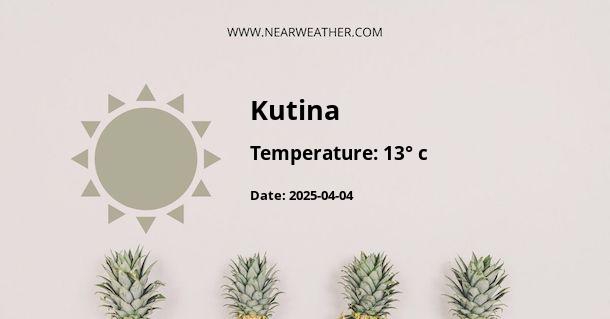Understanding the Climate and Weather Patterns in Kutina, Croatia
Kutina, a city located in the heartland of Croatia's continental region, exhibits a climate profile characteristic of the Central European and Pannonian zones. Understanding its climate oscillations and nuanced weather patterns requires an insightful look into its seasonal variations, meteorological data, and the implications these have on local life and activities. This comprehensive overview of Kutina's climate will delve into the specifics of temperature fluctuations, precipitation trends, and significant climactic events that define the city's yearly weather panorama.
General Climate Classification
Kutina is situated within a humid continental climate zone, classified under the Köppen climate classification as Dfb. This categorization informs us about its pronounced seasonality, with warm summers, cold winters, and a variable pattern of precipitation throughout the year. Such climates typically bring about stark contrasts between summer and winter temperatures, contributing to a rich diversity in seasonal experiences for both residents and visitors.
Temperature Overview
Temperature patterns in Kutina showcase a broad range of values across seasons. The following table represents average high and low temperatures for each season, providing a snapshot of typical temperature expectations for Kutina:
| Season | Average High Temperature (°C) | Average Low Temperature (°C) |
|---|---|---|
| Winter | 1 - 4 | -6 - -2 |
| Spring | 12 - 20 | 2 - 9 |
| Summer | 23 - 27 | 12 - 16 |
| Autumn | 11 - 18 | 3 - 9 |
The warmest month historically is July, with average high temperatures reaching upwards of 27 degrees Celsius, while the coldest month is January, where the average low can drop to -6 degrees Celsius. Transitional seasons such as spring and autumn, exhibit milder and more fluctuating temperature ranges, reflecting the changing climatic phases.
Precipitation Patterns
In combination with temperature shifts, precipitation in Kutina is an integral aspect to consider. The following bullet points delineate key precipitation statistics:
- Total annual precipitation: Approximately 750 mm
- Wettest month: Typically June, averaging around 95 mm of rain
- Driest month: Usually February, with about 40 mm of rainfall
- Snowfall: Mostly occurring in January and February
Snow is a common occurrence in the winter season, with the possibility of snow cover lasting for several weeks, impacting transportation, agriculture, and daily life. Conversely, summer and late spring may bring about occasional thunderstorms, critical for agriculture but also posing challenges such as flash flooding or hail.
Seasonal Weather Phenomena
Blockquote: "Kutina's climate is not without its unique weather phenomena, each bringing about a remarkable impact on the landscape and local customs. From the lushness induced by spring rains to the serene blanket of winter snows, every season carries its signature meteorological imprint." - Local Climate Expert
Seasonal weather events in Kutina can be striking:
- Spring: Marked by an increase in rainfall, promoting the blossoming of Kutina's flora.
- Summer: Prone to abrupt and intense thunderstorms, often accompanied by hail.
- Autumn: Noted for its foggy mornings, a result of cooling temperatures and lingering moisture levels.
- Winter: Characterized by frosty days and the occurrence of a meteorological phenomenon known as "inversion", leading to extended periods of cold and foggy weather, especially in the valleys.
Climate Impacts on Local Life
The climate and weather in Kutina significantly impact local life and activities. Agriculture is particularly sensitive to the variances in weather, with the success of crops like wheat, barley, and corn hinging upon the right climate conditions. The energy industry also responds to the weather patterns, with increased demand for heating during the cold winter months and a decreased need throughout the warm summer season.
For tourists, the best time to visit Kutina would be during late spring to early autumn when the weather is mild and conducive to outdoor activities. The city's events and festivals are often scheduled in this period to take advantage of the pleasant climate.
Climate Change Considerations
As with much of the world, Kutina is not insulated from the impacts of climate change. With trends indicating increased temperatures and altered precipitation patterns, the local ecosystem, agriculture, and urban life might face unprecedented challenges in the coming decades. Monitoring and adaptive measures will become increasingly critical for the region.
Advanced Weather Instrumentation and Data
Data collection and analysis are fundamental for understanding and preparing for Kutina's climate and weather variability. Advanced meteorological stations equipped with instruments like:
- Anemometers, to measure wind speed and direction,
- Hygrometers, to gauge humidity levels,
- Thermometers, to monitor air temperatures,
- Barometers, to observe atmospheric pressure,
- Rain gauges, to determine precipitation levels,
are vital for accurate forecasts and climatic studies.
In conclusion, Kutina's climate presents an intriguing interplay between continental climatic attributes and local geographical influences. The detailed temperature and precipitation profiles outlined above not only provide insights into what one can expect in terms of average weather conditions but also underscore the importance of seasonal and climate change considerations for the everyday life and future resilience of the region.
A - Kutina's Latitude is 45.474998 & Longitude is 16.781940.
A - Weather in Kutina is 7° today.
A - Climate Conditions in Kutina shows overcast clouds today.
A - Humidity in Kutina is 67% today.
A - Wind speed in Kutina is 13.14 km/h, flowing at 56° wind direction. today.
